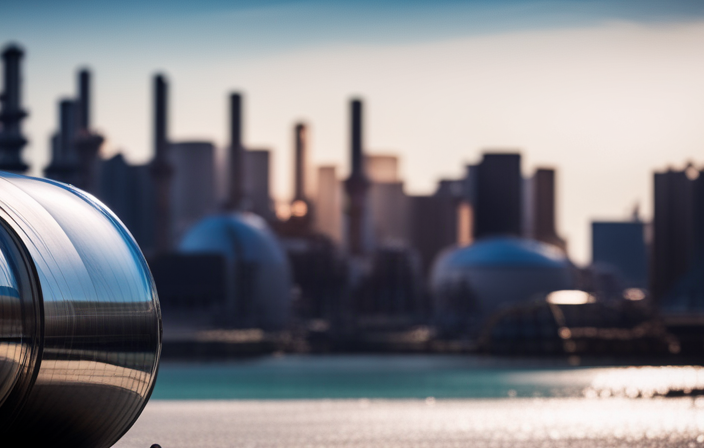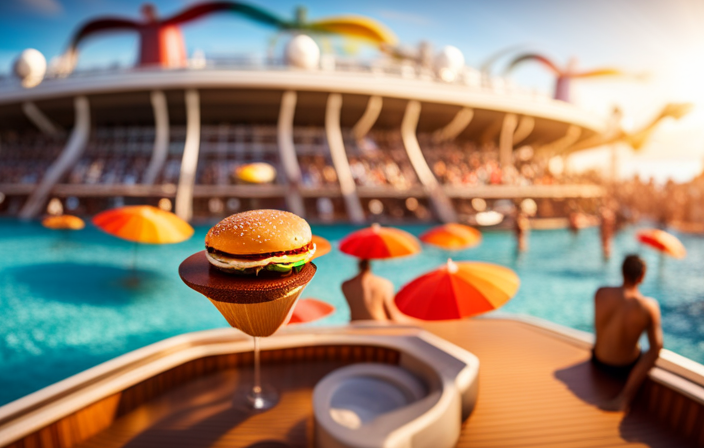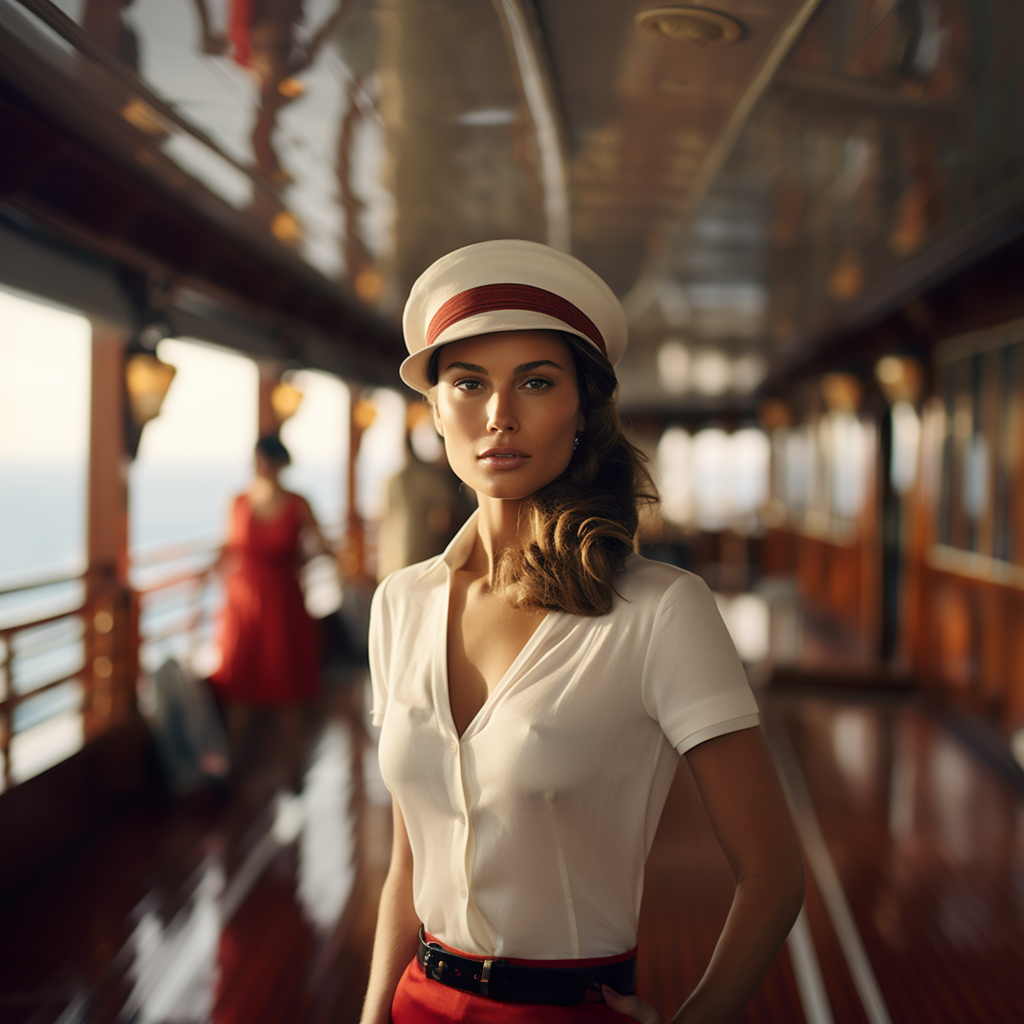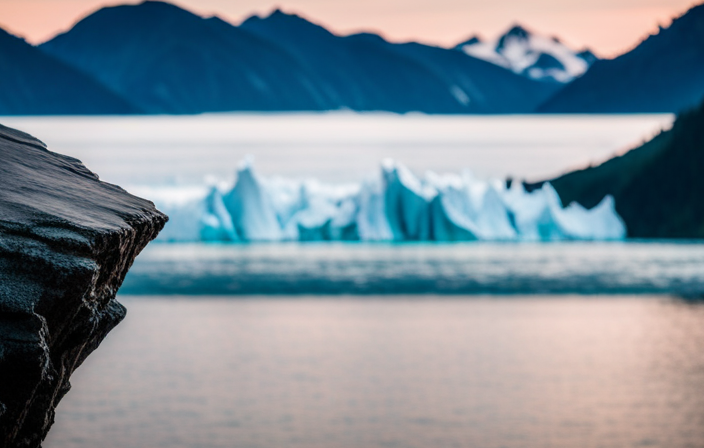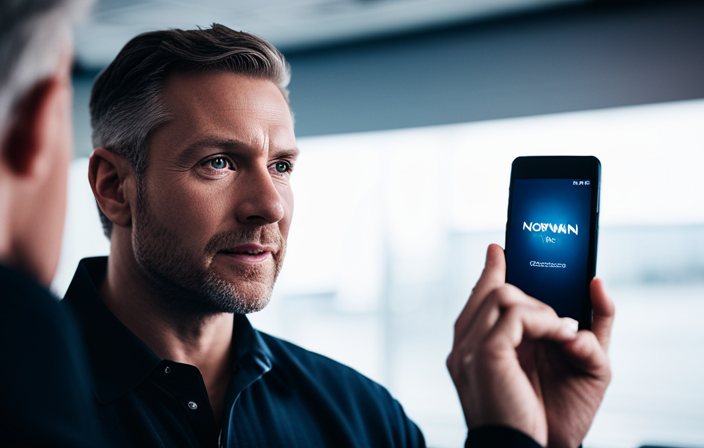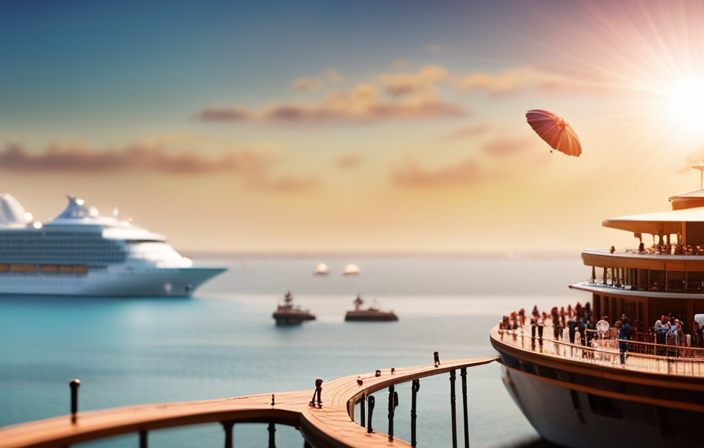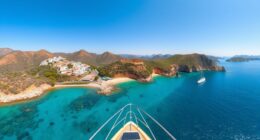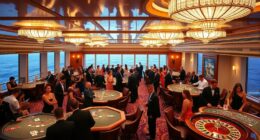Picture yourself relaxing on a luxurious cruise ship, basking in the sunshine as you sail across the glistening, clear waters. But, have you ever stopped to think about where all that water comes from? This fascinating question is what I plan to explore in this article.
You see, cruise ships rely on a variety of sources for their water supply, and it’s not as simple as just turning on a faucet. From onboard desalination systems to shore-side water supplies, there are intricate processes in place to ensure that every drop of water is safe and clean.
And let’s not forget about the importance of water conservation and sustainability initiatives. So join me on this journey as we dive into the depths of cruise ship water procurement and discover the fascinating world behind the scenes of where cruise ships get their water.
Prepare to be amazed!
Key Takeaways
- Cruise ships obtain water from different sources such as onboard desalination systems, shore-side water supplies, and rainwater collection.
- The desalination process involves filtration, reverse osmosis, and disinfection, along with storage and treatment processes.
- Rainwater collection is another method used to acquire water on cruise ships, which involves collection and filtration methods, but it has its own limitations.
- Cruise ships also employ water recycling and filtration systems, which use advanced technologies like reverse osmosis and filtration to ensure a sustainable water supply.
Onboard Desalination Systems
Cruise ships rely on onboard desalination systems to convert saltwater into fresh water. This ensures a sustainable and self-sufficient source of water for their passengers and crew. These systems utilize advanced water purification processes to remove salt and impurities from the seawater. The desalination process involves multiple steps, including filtration, reverse osmosis, and disinfection.
Filtration is the first step, helping to remove larger particles from the water. Then, reverse osmosis comes into play. It utilizes a semi-permeable membrane to separate salt and other impurities from the water, making it safe for drinking, cooking, and other onboard uses. After the reverse osmosis process, disinfection is carried out to eliminate any remaining microorganisms.
By utilizing these sophisticated systems, cruise ships can produce large quantities of fresh water to meet the demands of their passengers and crew throughout their journey. Additionally, when the ship is docked, it can switch to shore-side water supplies, further reducing its reliance on the desalination system.
Shore-Side Water Supplies
Shore-side water supplies are the key source of H2O for these majestic vessels. Cruise ships rely on shore side desalination facilities to ensure a steady supply of fresh water. These facilities use advanced technology to remove salt and impurities from seawater, making it safe for consumption and use onboard.
Water transportation logistics play a crucial role in delivering the purified water to the ships. This involves coordinating with local authorities and port facilities to ensure a seamless transfer of water. The logistics team ensures that the ships are supplied with sufficient water to meet the needs of passengers and crew throughout their journey.
Additionally, strict quality control measures are implemented to ensure the water meets the highest standards of safety and purity.
Transitioning into the subsequent section about rainwater collection, it is worth exploring additional methods of water sourcing for cruise ships.
Rainwater Collection
When it comes to collecting rainwater on cruise ships, there are specific systems in place to ensure an efficient process. Rainwater is usually collected from the ship’s deck and stored in designated tanks.
These tanks are equipped with filtration systems to remove any impurities before the water is treated for use onboard.
While rainwater collection is an effective way to supplement the ship’s water supply, there are limitations to consider. These include the availability of rain and the capacity of the storage tanks.
How cruise ships collect rainwater
Interestingly, experts have debunked the theory that cruise ships collect rainwater to supply their water needs. While rainwater harvesting is a common practice in areas facing water scarcity, cruise ships have different methods for obtaining water. They rely on desalination processes to convert seawater into freshwater. Desalination involves the removal of salt and impurities from seawater, making it suitable for drinking and other purposes.
Cruise ships use advanced desalination systems that employ reverse osmosis or distillation techniques. These systems effectively separate the salt and minerals from the seawater, producing clean and safe drinking water for passengers and crew members. Once the seawater is converted into freshwater, it undergoes storage and treatment processes to ensure its quality. These processes include filtration, disinfection, and pH adjustment.
Rainwater storage and treatment processes
Rainwater is stored and treated using filtration, disinfection, and pH adjustment processes to ensure its quality. First, filtration removes debris, sediment, and larger particles from the collected rainwater. This process typically involves passing the water through a series of filters of varying sizes, effectively removing impurities. Next, disinfection is carried out to eliminate any harmful microorganisms that may be present. Common disinfection methods include chlorination or ultraviolet (UV) treatment. Finally, pH adjustment is performed to regulate the acidity or alkalinity of the water, ensuring it falls within acceptable limits for human consumption.
To provide a visual representation, the following table shows the various rainwater filtration methods commonly employed on cruise ships:
| Filtration Method | Description |
|---|---|
| Sediment Filters | Removes larger particles and sediments from the water |
| Carbon Filters | Eliminates odor and improves taste by adsorption |
| Reverse Osmosis (RO) | Removes dissolved salts, minerals, and other impurities |
| UV Sterilization | Kills bacteria, viruses, and other microorganisms |
| Granular Activated Carbon (GAC) | Further removes organic compounds and chemicals |
Rainwater collection and treatment play a crucial role in addressing water scarcity impacts on cruise ships. By utilizing these processes, cruise ships can reduce their reliance on freshwater sources and contribute to sustainable water management. However, it is important to consider the benefits and limitations of rainwater collection for a comprehensive understanding of its viability as a water source.
Benefits and limitations of rainwater collection
Now that we’ve learned about the storage and treatment processes for rainwater on cruise ships, let’s explore the benefits and limitations of this collection method.
Rainwater collection offers several advantages for cruise ships. Firstly, it provides a sustainable source of water, reducing the reliance on freshwater supplies. Secondly, it helps conserve energy and reduce costs associated with water production and transportation. Additionally, rainwater is generally free from harmful chemicals and minerals, making it suitable for various onboard uses. Lastly, the collection process promotes environmental stewardship and supports the cruise industry’s commitment to sustainability.
However, there are limitations to rainwater harvesting methods. Firstly, the availability of rainwater is dependent on weather conditions, making it unreliable in certain regions. Secondly, the collection capacity may be limited, especially during dry seasons or in areas with low rainfall. Lastly, extensive filtration and treatment processes are required to ensure the water’s safety and quality.
In the next section, we’ll explore the fascinating world of water recycling and filtration systems, which play a crucial role in providing clean and safe water on cruise ships.
Water Recycling and Filtration Systems
Cruise ships rely on advanced water recycling and filtration systems to ensure a constant supply of clean and freshwater. These systems play a crucial role in addressing the issue of water scarcity and implementing innovative solutions in the cruise industry. By recycling and filtering water, cruise ships can reduce their dependence on external sources, minimize their environmental impact, and contribute to water conservation efforts.
One key technology used on cruise ships is reverse osmosis, which removes impurities and contaminants from seawater, making it safe for various onboard uses. Additionally, filtration systems remove sediment, bacteria, and other particles, ensuring the water meets stringent quality standards. These systems are carefully monitored and maintained to guarantee the safety and reliability of the water supply onboard.
Implementing such water recycling and filtration systems allows cruise ships to reduce their reliance on external water sources and contribute to sustainable practices. Transitioning to the subsequent section about water conservation measures, it is essential to explore additional strategies to further minimize water usage and promote responsible consumption.
Water Conservation Measures
Water conservation measures on cruise ships are essential for reducing water consumption and ensuring sustainable practices. Strategies for achieving this include implementing water-saving technologies and practices throughout the ship.
These can include the use of low-flow showerheads, dual-flush toilets, and water-efficient laundry systems. By conserving water, cruise ships can not only reduce their environmental impact but also benefit from cost savings and improved operational efficiency.
Strategies for reducing water consumption on cruise ships
To lower your water usage on a cruise ship, try implementing these savvy strategies:
-
Install low-flow showerheads and faucets. These innovative water conservation techniques can significantly reduce water consumption without sacrificing comfort.
-
Encourage passengers to reuse towels and linens. By promoting this simple habit, cruise ships can save thousands of gallons of water each day.
-
Implement a water monitoring system. By closely monitoring water usage throughout the ship, crew members can identify areas where water is being wasted and take corrective measures.
These strategies for reducing water consumption on cruise ships not only help conserve precious resources, but they also contribute to a more sustainable and environmentally-friendly cruising experience. By adopting these practices, cruise lines can minimize their impact on the environment and promote responsible tourism.
In the next section, we will explore water-saving technologies and practices that further enhance water conservation efforts.
Water-saving technologies and practices
By embracing water-saving technologies and practices, you can effortlessly sail towards a more sustainable cruise experience, like a ship gliding through calm waters. Cruise ships have implemented various water-saving technologies and conservation measures to reduce their water consumption.
One of the most common technologies used is advanced water treatment systems, which recycle and treat wastewater onboard, allowing it to be reused for non-potable purposes such as irrigation or cleaning. Additionally, ships are equipped with low-flow fixtures and sensors that regulate water flow, minimizing unnecessary usage.
Crew members also play a crucial role in raising awareness and encouraging passengers to conserve water through signage and educational programs. By implementing these water-saving technologies and practices, cruise ships not only reduce their environmental impact but also save on operational costs.
Transitioning into the subsequent section about the benefits of water conservation, these efforts not only benefit the environment but also enhance the overall cruise experience.
Benefits of water conservation
Water conservation benefits not only the environment but also the cruise ship industry. By implementing sustainable practices, cruise ships can significantly reduce their water usage and minimize their impact on the surrounding ecosystems. There are several benefits of water conservation in this sector.
-
Preservation of natural resources: Conserving water helps preserve precious freshwater resources, ensuring their availability for future generations.
-
Cost savings: By reducing water consumption, cruise ships can lower their operational costs, resulting in financial savings.
-
Environmental protection: Water conservation reduces the need for extracting and treating water, which in turn reduces energy consumption and greenhouse gas emissions.
-
Enhanced reputation: Adopting water-saving technologies and practices allows cruise companies to demonstrate their commitment to environmental stewardship, enhancing their reputation among environmentally conscious travelers.
Transitioning into the subsequent section about waste water treatment, it is crucial to understand how cruise ships manage their water after use.
Waste Water Treatment
Imagine standing on the deck of a majestic cruise ship, marveling at the breathtaking views of the open ocean, while unaware of the intricate waste water treatment systems that silently operate below you. Waste water management on cruise ships is a complex process that involves multiple stages of water treatment. These treatment processes aim to remove contaminants and ensure that the water released back into the ocean meets strict quality standards. Here is a table that provides an overview of the key steps involved in waste water treatment on cruise ships:
| Stage | Description |
|---|---|
| Preliminary | Removal of larger debris through screening and sedimentation |
| Primary | Separation of solid and liquid waste through settling and skimming |
| Secondary | Biological treatment to remove organic matter and nutrients |
| Tertiary | Advanced filtration and disinfection to remove remaining impurities |
| Discharge | Safe release of treated water into the ocean |
Quality control and testing play a crucial role in ensuring that the treated water meets the required standards.
Quality Control and Testing
While you soak in the stunning views of the open ocean from the deck of a majestic cruise ship, it’s important to understand the rigorous quality control and testing measures that ensure the treated water released back into the ocean meets strict standards.
Quality control measures are put in place to monitor the effectiveness of the waste water treatment systems onboard. Water testing procedures involve regular sampling and analysis of the treated water to check for any contaminants or pollutants. This ensures that the water meets the necessary criteria for discharge and helps protect marine life.
The testing includes checks for pH levels, dissolved oxygen, turbidity, and the presence of any harmful chemicals. By implementing these quality control measures and conducting thorough water testing procedures, cruise ships can ensure the environmental sustainability of their operations.
Transitioning into the subsequent section about emergency water supply, it is crucial for cruise ships to also have a reliable source of fresh water onboard.
Emergency Water Supply
On cruise ships, the availability of emergency water supplies is crucial in ensuring the safety and well-being of passengers and crew members.
In the event of water shortages or system failures, contingency plans are in place to address these issues and ensure that an adequate supply of water is always available.
Additionally, emergency response protocols are established to handle any water-related incidents that may occur, ensuring a swift and efficient response to maintain the safety of everyone on board.
Availability of emergency water supplies on cruise ships
You’ll be glad to know that cruise ships have readily available emergency water supplies in case of any unforeseen situations.
The availability of bottled water is crucial in maintaining the safety and well-being of passengers and crew members. Cruise ships ensure that an ample supply of bottled water is always on board, stored in designated areas for easy access during emergencies.
Additionally, the importance of water safety training cannot be overstated. Crew members receive comprehensive training on water safety protocols, including how to properly handle and distribute emergency water supplies.
These measures ensure that everyone on board remains hydrated and safe during any unexpected events.
Moving forward, let’s discuss the contingency plans for water shortages or system failures, ensuring a continuous supply of water for all passengers and crew members, without interruptions.
Contingency plans for water shortages or system failures
In the event of water shortages or system failures, cruise ships have contingency plans in place to ensure an uninterrupted and plentiful supply of water for everyone on board. These plans include a range of water shortage solutions and backup water sources. Here are four key components of these contingency plans:
-
Desalination: Cruise ships often have desalination systems on board, which convert seawater into freshwater. This process involves removing the salt and impurities from the seawater, ensuring a safe and drinkable water supply.
-
Water storage: Cruise ships have large water storage tanks that can hold a significant amount of freshwater. These tanks are regularly replenished when the ship is at port, ensuring a sufficient reserve in case of emergencies.
-
Water rationing: In the event of a water shortage, cruise ships may implement water rationing measures to conserve water usage. This can include reducing shower times, limiting laundry services, and encouraging passengers to use water sparingly.
-
Emergency water supplies: Cruise ships are equipped with emergency water supplies, such as bottled water or water purification tablets, to provide a temporary solution during system failures or when backup water sources are unavailable.
These contingency plans ensure that cruise ship passengers and crew members have access to clean and safe water at all times, even in the face of water shortages or system failures.
Transitioning into the subsequent section about emergency response protocols for water-related incidents, it is important to understand the steps cruise ships take to address such situations.
Emergency response protocols for water-related incidents
Imagine facing a water-related incident while aboard a cruise ship – what happens when emergencies strike and immediate action is needed? Cruise ships have emergency response protocols in place to ensure the safety and well-being of passengers and crew members. One critical aspect of these protocols is emergency response training, where crew members are trained to handle various water-related incidents such as leaks, floods, or system failures. Communication protocols are also established to ensure effective communication between crew members, allowing for quick and coordinated responses.
To grab your attention, here is a table summarizing the emergency response protocols for water-related incidents:
| Incident | Response Action | Communication |
|---|---|---|
| Leaks | Identify source and isolate the area | Notify bridge |
| Floods | Activate pumps and initiate damage control | Notify bridge |
| System Failures | Troubleshoot and repair the system | Notify engineers |
These protocols enable a rapid and efficient response to any water-related incident, ensuring the safety of everyone on board. Moving forward, let’s explore the cruise industry’s sustainability initiatives.
Sustainability Initiatives
Cruise ships have implemented various sustainability initiatives to minimize their environmental impact. These initiatives focus on sustainable solutions and eco-friendly practices throughout the ship’s operations.
One key area of focus is water usage and conservation. Cruise lines have adopted advanced water treatment systems to treat and reuse water onboard, reducing the need for fresh water intake. They have also implemented water-saving measures like low-flow faucets and toilets, as well as advanced laundry and dishwashing systems that use less water.
These efforts not only reduce the ship’s overall water consumption but also minimize the discharge of wastewater into the ocean. As cruise lines prioritize sustainability, future trends in cruise ship water procurement may include exploring alternative water sources like desalination or partnering with local communities to utilize their water infrastructure.
Future Trends in Cruise Ship Water Procurement
You’ll be amazed by the exciting future trends in how cruise ships will procure water.
Future innovations and technological advancements are set to revolutionize the way cruise ships obtain water.
One of the most promising advancements is the use of desalination technology, which converts seawater into freshwater. This process involves removing the salt and impurities from the water, making it safe for drinking and other uses.
Additionally, there are ongoing efforts to develop more efficient and sustainable water treatment systems on board cruise ships. These systems aim to reduce water waste and minimize the environmental impact of water procurement.
With the implementation of these future trends, cruise ships will be able to ensure a reliable and sustainable water supply, enhancing the overall experience for passengers while minimizing their ecological footprint.
Frequently Asked Questions
What are the main sources of water for cruise ships?
The main sources of water for cruise ships include onboard desalination systems, shore-based water supplies, and water delivered by tankers. These water sources undergo rigorous treatment processes to ensure they meet the necessary quality standards for drinking and other uses onboard.
How do cruise ships ensure the quality and safety of the water they provide to passengers and crew?
Ensuring water quality is vital on cruise ships. To maintain safety, we conduct regular water quality testing and utilize advanced filtration systems. Did you know that over 95% of cruise ships have onboard water treatment facilities?
Are there any regulations or standards that govern cruise ship water procurement and treatment?
Yes, there are regulations and water quality standards that govern cruise ship water procurement and treatment. These regulations ensure that cruise ships maintain safe and clean water for passengers and crew throughout their journey.
Are there any special measures taken by cruise ships to conserve water?
Cruise ships implement various water conservation efforts to minimize usage. Innovative water management technologies are employed, such as advanced filtration systems and water recycling. These measures ensure optimal water usage while preserving resources onboard.
What are some emerging trends or technologies in cruise ship water procurement?
Desalination technologies and water recycling systems are emerging trends in cruise ship water procurement. These innovative methods allow ships to produce fresh water from seawater and reuse wastewater, ensuring a sustainable and efficient water supply onboard.
How is Water Sourced and Stored on Cruise Ships?
Water on cruise ships is sourced from desalination plants or stored in large onboard water tanks. The process of sourcing and storing water is crucial for providing passengers and crew with a safe and reliable supply throughout their journey. This system operates with precise cruise control in accidents to ensure smooth operations at all times.
Conclusion
In conclusion, the procurement of water for cruise ships is a complex and multi-faceted process. Cruise ships utilize various methods to ensure a reliable water source, including onboard desalination systems and shore-side water supplies. Rainwater collection, water recycling and filtration systems, as well as water conservation measures, play a crucial role in maintaining a sustainable water supply. Quality control and testing are vital to ensure the safety of the water consumed on board.
As the industry continues to grow, sustainability initiatives and future trends in water procurement are being explored to further enhance the efficiency and environmental impact of cruise ship operations.
Meet Asra, a talented and adventurous writer who infuses her passion for exploration into every word she writes. Asra’s love for storytelling and her insatiable curiosity about the world make her an invaluable asset to the Voyager Info team.
From a young age, Asra was drawn to the power of words and their ability to transport readers to far-off lands and magical realms. Her fascination with travel and cultures from around the globe fueled her desire to become a travel writer, and she set out on a journey to turn her dreams into reality.

